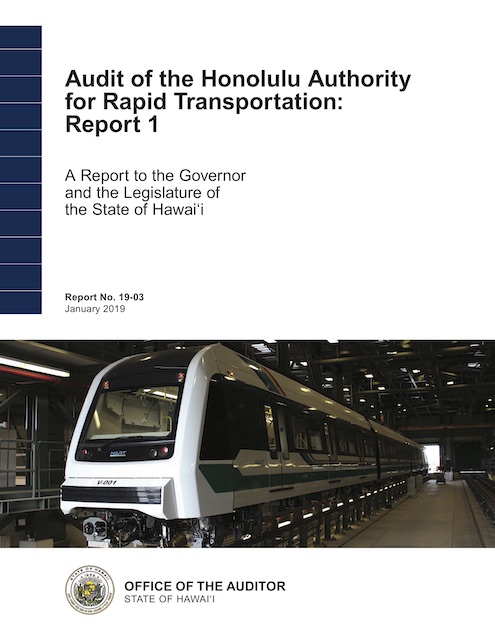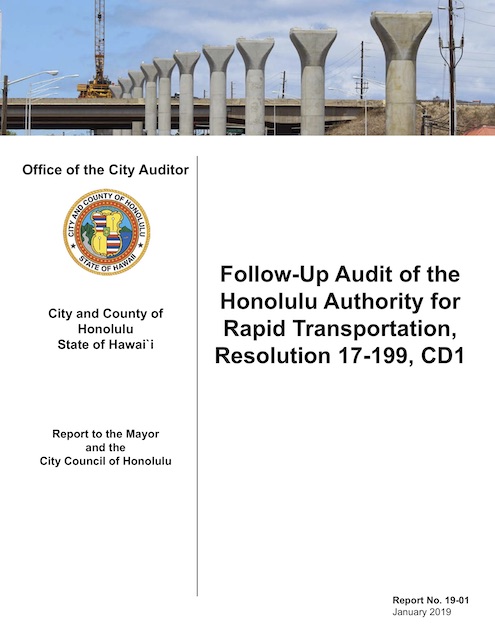Recent audits of Honolulu Authority for Rapid Transit (HART) by the city of Honolulu and state of Hawaii provide a backroom view of how the rail transit-industrial complex is scalping taxpayers. Honolulu’s rail line, which was originally supposed to cost less than $3 billion, is now expected to cost well over $9 billion, thanks to poor planning and HART essentially letting the foxes (in the form of outside contractors) guard the chicken house (the public purse).
The first of four state audits (summarized here) says that the city hastily signed contracts committing itself to the project before all environmental and financial reviews were completed. The audit doesn’t say so, but the city did this to prevent opponents, who were marshaling legal and political forces against the project, from stopping it.
The audit also says that HART staff have been less than honest about costs and cost overruns. It reported different numbers to different audiences and kept the real numbers hidden from the public as long as possible. “Internal alarms of rising project costs and scheduling delays were not shared in a timely manner by HART management with the Board, the Legislature, or the public,” charges the report.
The second state audit (summary here) goes into detail about the incestuous relationship between HART and its consultants. HART has farmed out many of its senior management positions to the consulting firm HDR, and pays HDR an average of more than $500,000 a year per staff member. “Yet HART does not evaluate the performance of the embedded HDR employees.”
The recent city audit (summary here) says that the auditor told HART in 2012 that it should replace 16 HDR workers with its own staff, yet by 2018 it had only replaced six of them.
Beyond the high cost per employee, another problem with letting the consultants run the show is that they make work for their firms by issuing hundreds of change orders. Between 2008 and 2016, HART issued 208 change orders and 63 contract amendments that collectively added almost half a billion dollars to the project cost and delayed the project by several years. “Contract files often lacked key documents such as independent cost estimates, records of negotiation, or proper approvals,” reported the city auditor.
“As the FTA has pointed out,” reports the state auditor, “filling key management positions with third-party consultants instead of HART employees is less than optimal, leading to less ‘ownership’ and accountability.” As the city auditor concludes, “cost overruns and schedule delays resulted from inexperienced HART managers and contractors who initiated and approved a plethora of change orders and amendments without sufficient justifications.”
Two more state audits have yet to be published. But the audits so far show what the Antiplanner has long contended: Rail transit is far more expensive, far more complicated, and — because rail lines can’t be easily changed if they end up going to the wrong place — far riskier than bus transit. Honolulu fell into the trap of thinking that, because it ran one of the most systems bus systems in the United States, it could build a rail line.
HDR and other companies have certainly profited from that delusion, while the politicians who promoted it are either no longer around or are otherwise insulated from the negative outcomes of the project. It would be nice to think that other cities could learn from this experience, but this is far from the first rail transit disaster, and if cities were able to learn from others’ disasters, Honolulu would never have gotten into this situation in the first place.










Even Streetsblog hasn’t published shit about this disaster. Because they know its garbage, too expensive, politically corrupted and will serve no purpose whatsoever. Its oldest article since 2012 chronicles whether its good to abandon projects if construction has already started………….the more ethical question is it right to continue when the budget triples in as little as 8 years.
Unless and until criminal charges are brought against HART (or other agencies like them) people who gave false information to the city, state or auditors, this will never change.
If one of us filed a false tax return or lied to a government investigator, we are in big trouble.
But these guys take (and get to keep) millions of taxpayer $ and that is okay.
Somewhere in the file for every corrupt transit project in the last 50 years is a report filled with bullshit and lies that was concocted by a corrupt consultant and accepted without question by either FTA or FRA. Has any employee of either agency ever been fired for corruption, incompetence or dereliction of duty?
I’m involved with people fighting an extremely flawed/corrupt project in my own area.
Something is definitely a wrong with a project when even rail advocates are against it :$
http://trainsparence.ca
masturbating to their website doesn’t technically qualify as being involved.